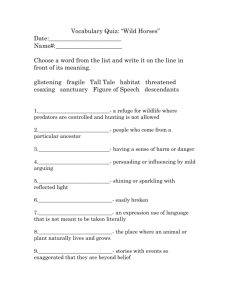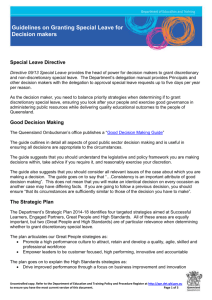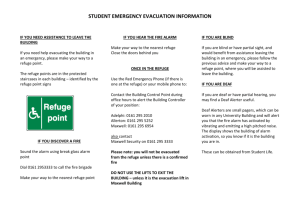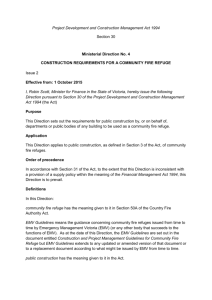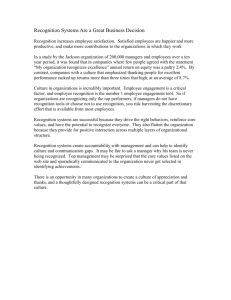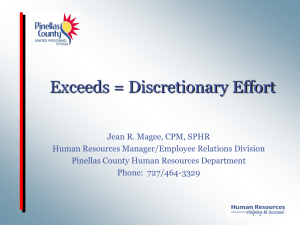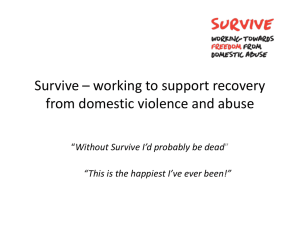tma04
advertisement
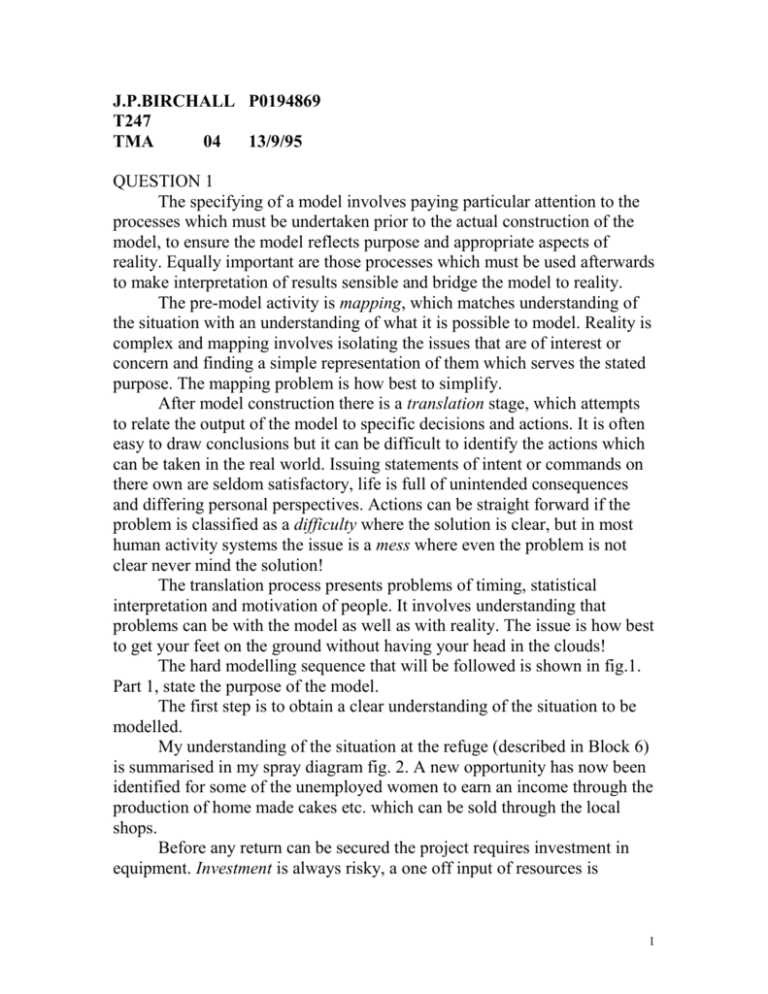
J.P.BIRCHALL P0194869 T247 TMA 04 13/9/95 QUESTION 1 The specifying of a model involves paying particular attention to the processes which must be undertaken prior to the actual construction of the model, to ensure the model reflects purpose and appropriate aspects of reality. Equally important are those processes which must be used afterwards to make interpretation of results sensible and bridge the model to reality. The pre-model activity is mapping, which matches understanding of the situation with an understanding of what it is possible to model. Reality is complex and mapping involves isolating the issues that are of interest or concern and finding a simple representation of them which serves the stated purpose. The mapping problem is how best to simplify. After model construction there is a translation stage, which attempts to relate the output of the model to specific decisions and actions. It is often easy to draw conclusions but it can be difficult to identify the actions which can be taken in the real world. Issuing statements of intent or commands on there own are seldom satisfactory, life is full of unintended consequences and differing personal perspectives. Actions can be straight forward if the problem is classified as a difficulty where the solution is clear, but in most human activity systems the issue is a mess where even the problem is not clear never mind the solution! The translation process presents problems of timing, statistical interpretation and motivation of people. It involves understanding that problems can be with the model as well as with reality. The issue is how best to get your feet on the ground without having your head in the clouds! The hard modelling sequence that will be followed is shown in fig.1. Part 1, state the purpose of the model. The first step is to obtain a clear understanding of the situation to be modelled. My understanding of the situation at the refuge (described in Block 6) is summarised in my spray diagram fig. 2. A new opportunity has now been identified for some of the unemployed women to earn an income through the production of home made cakes etc. which can be sold through the local shops. Before any return can be secured the project requires investment in equipment. Investment is always risky, a one off input of resources is 1 required before there is increased or improved output. It is this expectation of increase or improvement which is the return. The refuge is not simply goal directed with a profit objective but a multiple stakeholder system where returns are less tangible. Both the women and the support group are stakeholders, that is they are more than participants, as they both invest their own time and interest in the refuge. A more subtle social exchange is involved, perhaps the return the women expect is security, while the support group may look to job satisfaction. The two groups will have different perspectives, on the one hand the women are looking for an additional income stream and useful personal contributions whereas the support group maybe worried about the investment risk and the effect on the financial stability of the refuge and future refugees. It is the reconciliation of these potentially conflicting goals that is the crux of the issue. In voluntary organisations where there is discretionary exchange the evaluation of investment cannot be a simple quantification of financial return on investment. The model will attempt to include the effects of social exchange where personal interests and contributions are not obligatory but discretionary. It is mediation of differing interests that is involved not a control of finance. Thus, the purpose of the model is to provide quantified output data which will help the support group to make a decision on investment of resources in equipment for the production of home-made cakes etc. for sale at a profit. It will address the particular concerns of the risk associated with there being too few women to help with production at the very time refuge income from other sources is short. Part 2, describe the nature and structure of the model. The second step in the modelling process is to map the situation understanding into the model specification. The model will be a static model quantifying the investment and the return in terms of both finance and time, and have stochastic elements associated with the availability of women for work and the variability of the refuge income. The structure will be similar to the ‘insurance model’ in Block 2, there the number of deaths was random within an expected range and the investment income was variable due to the unpredictable nature of interest rate variation. In this case the number of women available for work and the refuge income will replace the number of deaths and the investment income. The model will calculate the net refuge income and the financial return on investment (the equipment cost) from labour availability and 2 material costs, and cake production and selling price. The discretionary investment cannot be quantified directly so it will be will be modelled by proxy variables representing the women’s work time and a factor associated with income from other sources. Thus, both the women’s time and other refuge income will not only vary randomly within limits but also depend on a factor representing discretionary input of time. Part 3, state the main variables in the model and the relationships involved. The main variables are: the number of women available for work this is randomly variable from the current number available, say, 8, to plus or minus, say, 2 and 4, with an equal chance of plus/minus 2 and a 50% chance of plus/minus 4. the time they are prepared to invest this is to be set as a norm of 8 hours per day with a factor to represent the additional discretionary investment which can be called on. This will factor will be 1, initially, but could be changed during analysis up to say, 1.5 representing a 12 hour day. Or conversely down to 0.5 if lack of enthusiasm or alternative essential tasks lead to part time working. the number of cakes produced this will follow from the number of women hours required to make a cake. the selling price this will be assumed to be fixed in the short term but the model will be able to accommodate a changed price. income from cake production this will follow from production and selling price, the assumption being that all cakes will be sold. * other refuge income this is to be set to vary randomly within a normal distribution with a mean of last year’s income and a range of +/- 50%. * net refuge income this is the main model output * discretionary additional income to represent the possibility of additional discretionary investment a factor will be applied to other refuge income. Initially this will be 1 but could be changed on analysis up to 1.5 or down to 0.5 in the same way as the discretionary factor associated with work hours investment above. 3 At this point I iterated and realised that the additional refuge income from discretionary exchange would depend on the level of time investment in cake production. In other words the more time that went into cake production the less maybe available for alternative sources. Thus the factor will be adjusted too limit the total discretionary hours, the extra hours invested in cake production will be subtracted from the total available for investment in other income sources. * potential refuge income this will include the discretionary income. * return on investment this is a subsidiary model output allowing a conventional financial investment criteria to be applied. Other variables initially assumed to be fixed: the number of women hours per cake the cost of cake materials other sundry costs, electricity, repairs, cleaning, transport, wastage/spoilage/returns... The relationships between the main variables are shown in the sign graph diagram fig. 3. It will be clear from the above that the selection and quantification of variables is not straightforward. Even the quantification of some ‘easy’ variables, for example, the price of the cakes, is fraught with difficulty. This has been assumed constant, but in reality price is bound to effect the quantity sold. Similarly choosing an appropriate measure of performance can be a problem, see the comments below on return on investment. Apart from the model design, covered above, the third and fourth steps in fig.1, the construction and testing/debugging of the model, are not required. Part 4, explain how the model output will be used. The fifth step is to use the model to obtain output. Firstly, the model will be used to obtain net refuge income data and return on investment for a series runs. Each run will involve the random change to the number of women available for work and random fluctuations in the refuge income. Secondly, a sensitivity analysis will be undertaken to establish the effect on net refuge income and ROI of varying the discretionary factors affecting the number of hours each women is prepared to invest, and refuge income from other sources. These factors will cover a +/-50% investment change as indicated above. The sixth step is to draw conclusions from the model. 4 The key conclusions will come from the variability in income from the inherent variability of the number of women workers and the variability of other income sources and particularly the chances of low income and low numbers coinciding. Because of the stochastic nature of these inputs conclusion must be based on a statistical interpretation of several runs. It would be sensible to look at a frequency distribution of the number of occasions that the reduced number of women coincides with low other income. Further conclusions will come from the sensitivity analysis. This will show how easy or difficult it would be for the adverse coincidence to be rectified by additional discretionary investment. What the model will not do is to tackle the thorny problem of how discretionary exchange is encouraged or discouraged. However, at least the effects of any investment can be modelled. It would be appropriate to draw a graph of average income verses discretionary investment to help visualise the effect of increasing levels of investment, say, in increments of 10%. If the effect on income is relatively flat (i.e. insensitive to the changed input) the initial conclusion maybe robust. The difficult seventh step is to translate the model output into real options. This is the key to how the model output is to be used. It involves both understanding the model and understanding the options in real life with all their associated practicalities (or impracticalities!). A first caution applies to the financial measure of return on investment. Because the model does not cost the input of hours the return on investment could be unusually high and conventional yardsticks for comparison cannot apply. A return of 45% when a Post Office account is only paying 5% is not a valid comparison. The second caution is that in all investment evaluations there are always alternative choices for the investment of the resources concerned; the model is silent on possible alternatives. (Apart from the attempt to limit the total discretionary investment). The support group should be made aware that the proposal involves an element of risk reduction through portfolio investment as the equipment will be used for a variety of products not only cakes but also, pies, biscuits and other confectionery. Similarly, although the model has been written for cake it is also applicable to the other varieties with suitably changed data inputs. It maybe that when available hours are short it is more advantageous to concentrate on the product(s) which has lower input hours per unit of 5 sales revenue. Thus there is an issue associated with an optimal mix of products. The question for the support group is do they approve the proposed investment request. Realism does not only mean addressing the initial worries of risk of low numbers of workers and low other income but also addressing the consequences of refusal, particularly the effect on the women if their idea is turned down. Cognitive mapping may help the support group to gauge such consequences remembering that orientation to work, or motivation, can be a complex mix of friendship, power or fulfilment as well as money. In bridging to reality it is always helpful to look for hidden agendas, espoused theory may not be theory in practice and the motives of either group could be influenced by an interest in the sale of the manufacturing equipment itself! For example, a brother who makes a good profit selling his food mixers! Lastly it is important to ensure the support group is not seduced by the quantitative nature of the model. Numbers often give an unintended aura of accuracy. To dispel this impression it may be possible to impress upon the group the need for careful judgement by soliciting from them their opinions on the scope for further discretionary exchange and using such figures as the factors in the sensitivity analysis. The final step eight is for the support group, the decision is theirs! 6 7 8 9 QUESTION 2 As a member of one of the groups engaged in the dialogue project targeted at decision makers concerned with nuclear armament/disarmament, I propose to analyse the situation using the Soft Methodology described in the Summer School Student Handbook. The methodology is outlined in fig. 4. Step 1, the unstructured situation. The dialogue project is described in Block 7. Step 2, the rich picture and problem themes. My rich picture of the situation is show in fig. 5, and I identified the following problem themes:1. no cost/benefit analysis of the current strategy; with escalation resulting from a system with no monitoring system - no negative feebabck loop, an absence of performance measures leading to sub optimisation where current objectives make everyone worse off. 2. faceless unaccountable decision makers; this could be the result of the system being run as simple goal directed when in reality it is a mulitiplestakehoder system effecting everyone 3. helplessness of Joe Public who pays the money and suffers the appalling consequences of nuclear destruction; the issue is how best to influence big systems, suggesting Joe is ineffective as a change agent. Step 3, the root definition. The problem theme developed was Joe’s helplessness and how best change agents should operate. My root definition of a notional system which maybe relevant is:‘A system to enable Joe Public (the tax payer) to influence the decisions made by key people, who are engaged in conflict with the enemy, to avoid defeat’. I did a CATWOE check on this definition:The customer is Joe who would benefit from the ability to influence. The process involved is the decision making process transforming options into actions. The world view is one of unresolved conflict between adversaries. The owners who have the power to change the system are the key decision makers. The environmental constraints are the enemy who, given the chance, will engage in aggressive activities resulting in destruction. 10 Identifying the actors caused me some difficulty, as it is clear that the people who would carry out the enabling activities would be both Joe and the decision makers themselves. Both would have to be involved. Step 4, the conceptual model. Fig. 6, shows my conceptual model. The important verbs identified in the root definition which resulted in subsystems in the model were - to influence, to decide, to engage and to avoid. At this stage I iterated and looked more closely at the decision making system which appeared to involve a feedback loop. This resulted in a second conceptual model based on the control model, shown also in fig. 3. The bottom part of the model show the activities where resources are invested in a system to engage the enemy and the output is avoiding defeat. The upper part of the conceptual model is the decision making process where actual outcomes are compared with targets which result in an appropriate response. Step 5, compare the conceptual model with reality. In comparing each item in turn several ideas for change emerged. Firstly the idea of withholding tax to directly stop the flow of funds into the armaments industry was an option. However before thinking through the practicalities of this I iterated and requestioned the whole system; in reality counting bombs appeared to be the set point and the method of engagement? The measure of performance appeared to see the absence of war as a victory. The set point in a democracy should be the wishes of the people, in reality there was no means of establishing such wishes. Absence of war is a rather negative objective, peace and co-operation would be far more positive. The response appeared to be almost automatic. Defence of the realm involved equipping yourself with enough fire power to match your opponent in conflict. This was undoubtedly the conventional wisdom. The decision makers were simply implementing the conventional wisdom. It was not the decision makers who should be the target of influence but conventional wisdom. This gave me a host of new insights. I chose to analyse the insight that the decision makers were not the key, they merely reflected public opinion, public opinion should be the target for our efforts. The dialogue project should be concerned with identifying the best strategies, or behavioural options, for influencing the conventional wisdom, there were far more people involved than a limited number of key decision makers. 11 Big systems appear to the participant as massive monolithic power groups, with the odds stacked against his small voice reason. There is a cognitive dissonance, the same reality is viewed from many different perspectives and when beliefs and reality clash there is a problem. To resolve this problem and get to grips with changing public opinion we must understand how different perspectives emerge. Reality is highly complex and the human brain must simplify if it is to function. The brain produces a model of reality, that is, a simplified representation for a specific purpose and, as such, it has only limited application. We expect too much from the model in our brains, it is only one view of the world, only one perspective. Modelling difficulties arise from selection and inaccuracy of data, the model structure, in that perceptions are at a particular level of detail, with a boundary defining what is of interest. However, the environment is not benign, it cannot be excluded, there are connections and interactions, resulting in emergent properties and unintended consequences of actions. With this holistic world view, novel insights emerge. The nuclear armament big system functions like most systems; outcomes are the result of a host of specific satisficing decisions, chosing the best option available at the time. The systemic properties then emerge as a consequences of the many interactions of these components. It is clear from this perspective that the original strategy of isolation the individual decisions that result in policy was right. However, the decision makers are not only those at the top of the organisation. The basic error was to assume a top down, command view of the world. This perspective is very plausible, particularly for scientifically trained western Europeans. The success of science is the result of a reductionist approach where the environment is excluded and models can be developed by isolating the effects of specific variables. This approach falls down when complex human activity systems are involved. The novel approach is to widen the boundary look at the totality, the myriad of decisions which together, as a whole, result in the immorality and hopelessness of nuclear conflict. We have changed the focus and can look at a different level in the system. Initially this may appear to make the problem worse because instead of targeting a few top decision makers we are now looking at many much smaller decisions both inside the original system and outside in the environment. However, all is not lost because ‘good’ strategies may be popular, if there are opportunities for people to benefit from participation, their investment in time and persuasion will produce a good return in term of 12 satisfaction and contribution. They become stakeholders involved in social exchange, where co-operation brings more benefit than conflict. Step 6, debate the feasible and desirable changes. The appropriate strategy to propagate is a tit for tat strategy. This is a nice strategy. Essentially it involves co-operating with adversaries until such time as they become aggressive, (in game metaphor language until they defect), and then react with force. The strategy can be forgiving in the sense that if the adversary ceases his aggressive action we revert to a co-operative position. Initially this tit for tat strategy can be sold to the nuclear lobby on the grounds that they are not wrong but their weapons are purely for reaction to aggression. However, if the nice strategy is made explicit, co-operation will emerge as the way forward, everyone will gain, it is not a zero sum game, but the understanding is that force will be met by force. The espoused theory must be seen as identical to the theory in practice. But the crux of the nice strategy is that once participants see the benefits of co-operation they will learn and have good returns from their investment; disarmament then becomes a realistic probability, another co-operative action. The way the nice strategy propagates from small decisions, anywhere within the big system or outside it, is through a process of colonisation. Like minded people, only a small group to start with, can adopt appealing nice tit for tat strategies of co-operation and they will spread as people learn. The key is the benefit of co-operation, the increased return on investment, not in financial terms but in terms of social exchange theory. Big systems are not changed from the top down they evolve from the perceived benefits of co-operation from any group of like minded people. Starting from small beginnings we can colonise the world, not with guns and top down commands but through the spread of benefit. After this analysis I was confident my voice could be heard. Of the options before me of voice, exit or loyalty. The choice was now easy. On further reflection (iteration!), I realised the strength of my argument could be increased by noting that the Strategic Defence Initiative in the US provoked a reaction in the USSR that resulted in the understanding that co-operation was the way forward because the arms race was too expensive. The peace dividend has become conventional wisdom! 13 14 15 16 17
